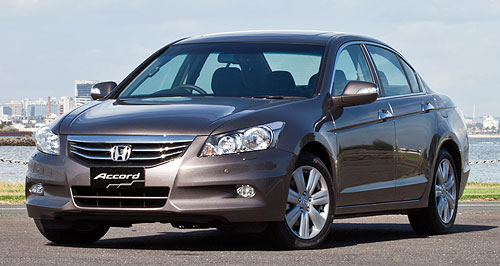New models - Honda - Accord - sedan rangeHonda backs two-model Accord strategyStill in Accord: The facelifted 2011 model Honda Accord with its distinctive chrome two-bar grille. Honda Australia to support ongoing Accord in the face of Accord Euro dominance28 Sep 2011 HONDA Australia will continue with its innovative two-pronged Accord strategy, despite falling sales for the larger of the two distinct models. While the introduction of a mid-life facelift and lower pricing on July 1 has succeeded in boosting sales of the Japanese-built Honda Accord Euro, the same cannot be said of the larger Thai-built Accord. Honda Australia slashed the prices of 2010-plated Accords by between $4291 and $6259 on June 1, then a month later introduced a facelifted MY2011 model with extra equipment – with little response from the market. Honda Australia senior director Lindsay Smalley, who this week announced his impending retirement, said the company was still satisfied with the two-model arrangement, which started in June 2003 after Honda went with two separate development paths globally. While a larger Accord was developed specifically for the US, Japan produced a smaller (though similar to the superseded model) version for its domestic and European markets. Honda Australia decided to take both – with the larger Accord stepping into the large-car segment alongside the likes of the Holden Commodore, Ford Falcon and Mitsubishi Magna – and called the mid-sized Japanese-built model the Accord Euro. “We are very happy with our current strategy to offer both the Accord and the Accord Euro,” Mr Smalley told GoAuto this week. “The large segment provides challenges for all manufacturers. It has dropped by 21 per cent year-to-date compared with 2010. “The Accord currently has 3.3 per cent market share compared with 4.6 per cent in 2010. Accord sales have therefore stood up to a market that has contracted significantly over the same period.  “Regards Accord Euro, the medium segment has dropped by 8.3 per cent YTD compared to 2010. The Accord Euro currently has an 8.2 per cent market share YTD compared to 8.4 per cent in 2010. This figure has remained fairly consistent over the last few years. “The Accord Euro remains a strong performer in this segment. “We realise the landscape is changing, however we are very confident both the Accord and Accord Euro offer our customers excellent value for money.” Accord Euro buyers certainly responded to the July launch of a facelifted model that is $1150 cheaper, defying a downward overall trend for Honda by rising 17.3 per cent in July (compared with the same month last year) and 32.6 per cent in August. However, its bigger sibling has seen sales continue to slide. Despite the large price decreases, Accord sales dropped 38.2 per cent in June, the month after they were announced, then fell a further 18.5 per cent in July and 56.7 per cent in August, when just 129 examples were sold compared with 407 Accord Euros. Year-to-date, Honda has sold only 1661 Accords – 46.5 per cent fewer than last year – while Accord Euro sales are down 19.9 per cent to 3059. In an attempt to stimulate sales, Honda Australia effectively re-released the facelifted Accord this week, believing its low-key introduction at the recent Melbourne motor show was lost in the new-model onslaught and Honda’s late slot in the media presentations. Its introduction had already been delayed – it was released in the US in August last year – as Honda tried to shift slow-moving stock of 2010 models. Cosmetic changes for the 2011 model year include a new grille with two chrome bars instead of the previous all-black treatment, a revised front bumper design and the addition of a chrome highlight strip across the boot-lid. Fuel consumption for the 2.4-litre four-cylinder engine in the VTi and VTi-L models has been improved slightly, dropping from 8.8 to 8.7 litres per 100 kilometres on the combined cycle, although output is unchanged at 133kW of power and 222Nm of torque. There is no change to the 202kW/339Nm 3.5-litre V6 engine fitted to the V6L model, which features Honda’s Variable Cylinder Management system that allows the engine to operate on either six, four or three cylinders to improve fuel economy and emissions. Specification improvements in the range include the addition of a USB port to allow connection of personal music devices, an A-pillar mounted Bluetooth system and a new foldaway key design. Pricing for the base VTi model remains at $32,490 – the figure that applied before the heavily discounted 2010-model prices were announced, and which still apply. Luxury variants gain significant extra equipment and are also still at pre-discounted pricing – $39,990 for the four-cylinder VTi-L and $49,990 for the V6L – while 2010-plated versions are still available at $34,507 and $43,731 respectively. Standard equipment on the Luxury models now includes satellite navigation, front parking sensors (V6L only), reversing camera, a premium audio system with subwoofer, dual air-conditioning and new five twin-spoke 17-inch alloy wheel designs. Newly appointed Honda Australia director, and sales and marketing general manager, Stephen Collins said: “The Honda Accord represents excellent value for money. Its spacious interior combines with superior comfort and handling with the perfect combination of power and fuel economy.”  Read moreAccord pricingMotor industry news |
|















Facebook Twitter Instagram